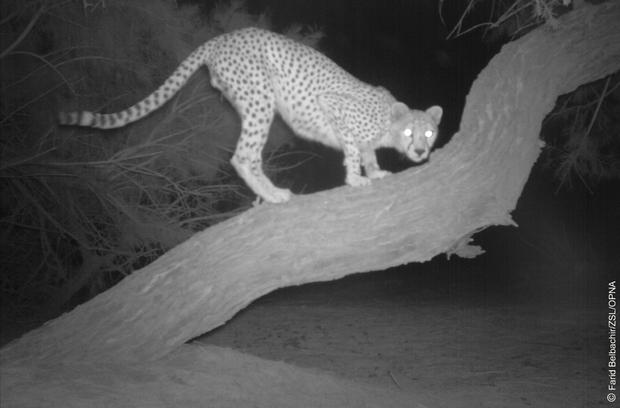Night-vision photos show elusive Saharan cheetah
Scientists have finally caught up with the rare and elusive Saharan cheetah.
Placing 40 camera traps throughout a park in Algeria, an international team has come away with some of the first images of this secretive cat, whose numbers probably total less than 200.
"It was fantastic. When we planned the survey, we had some idea there might be cheetah there because we'd found cheetah scat (droppings) and extracted cheetah DNA from it," Sarah Durant, one of the co-authors on study on the cheetahs in PLOS One, told CBS News.
"We had no idea whether we would get any photos or not," said Durant, who works at the Zoological Society in London and the Wildlife Conservation Society in New York. "It was a tremendous relief because it's a lot of work to do these surveys. If you come back with nothing, it's very frustrating."
The 32 images of five different cheetahs from 2008 and 2010 will provide valuable data that should help researchers better understand the cheetahs as well as provide the basis for conservation plans.
The study found the cheetah's density was much lower than their counterparts in other parts of Africa - probably only two animals per 10,000 square kilometers (3,861 square miles) - and their ranges stretched to 1,583 square kilometers.
Based on that, researchers estimated there are probably fewer than 200 Saharan cheetahs in the wild, mostly in Algeria and possibly parts of Mali and the eastern side of Libya. Their range has shrunken from the past when they were widespread across the entire Sahara, all the Egypt and through to Mauritania.
"They are incredibly sparse in the desert," Durant said. "It may be there is some sort of loss of prey keeping them at low densities or it be may natural. We know so little about these animals. It's very difficult to say straight off."
The study also found that their range is "severely constrained by the harsh desert environment" and that they often are active in the dark of night - an unusual trait for big cats.
"We only got one sighting actually during daylight hours. All the others were at night," she said.
"They were right in the middle of the night," she said. "It might be simply they are avoiding the heat of the day but I would expect them to be active at dawn or dusk. That is quite common among carnivores. It is possibly an avoidance strategy for people since they are very exposed if they are seen."
John Newby, the CEO Sahara Conservation Fund who did not take part in the study, called it "an important piece of research, not only because of the rather extreme logistical constraints under which it was carried out but also because of its focus on one of the Sahara's most endangered and charismatic species. "
"The fact that cheetah continue to persist in spite of naturally low numbers and density in a harsh environment increasingly impacted by human activities is testimony to their amazing adaptations and resilience," he told CBS News in an e-mail interview. "As mentioned by the authors, these realities are also increasingly augmented by growing security risks, which compromise research and conservation activities, but also increase the availability of desert-going vehicles and automatic weapons."
While they have the trademark spots of cheetahs, the Saharan species look different than those found in East Africa. Rather than having round, fat faces, Durant said they have dog-light snouts and "pointed, angular" heads. Considered a subspecies, they have been shown to be genetically distinct from their cousins across the continent.
More genetic work is expected to be done on the cats to understand whether they may be related to other nearby populations.
"It would be good to understand the extent of that subspecies," Durant said. "Is it just the Sahara? Does it go down to the Sahel? There is a cheetah population in southern Niger, northern Benin, and east Burkina Faso. It could be the same subspecies in Chad in Zakouma Park."
The researchers are hoping these findings will inform several conservation efforts in the works, including the North, West and Central Africa strategy for cheetah conservation and one that is being drawn up by the Algerian government. Among the challenges of any plan is addressing a shortage of prey - the addax and dama gazelle have already gone extinct in the cheetah's range - as well as threats from humans, from illegal hunting to overgrazing by herders.
"If the situation remains as it is the future of the Saharan cheetah is not bright, unless the Algerian Government set up a Strategy and an Action Plan for the sustainable conservation of the cheetah in Algeria, while taking severe measures against wildlife poaching, particularly cheetah's prey species," said one of the other co-authors Farid Belbachir, adding that it "requires a profound change in the behavior of local people towards carnivores and other biodiversity resources, and a strong political will" of governmental institutions.
But Newby cautioned that any effort to raise the profile and provide additional protection for the cheetah must be done with the cooperation of local Twareg herders, who would be concerned about the loss of their livestock.
"Whether the cheetah is a useful flagship species or not really depends on one's perspective," Newby said. "From a foreigners point of view, it surely is but imagine the position of a Twareg herder. Our work in Niger with Twareg herders suffering livestock predation from jackals has shown that all predators are seen as a potential threat and this includes the cheetah in spite of its rarity."
